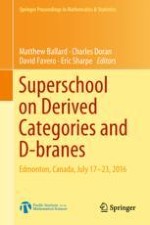2018 | OriginalPaper | Buchkapitel
An Overview of B-branes in Gauged Linear Sigma Models
verfasst von : Nafiz Ishtiaque
Erschienen in: Superschool on Derived Categories and D-branes
Aktivieren Sie unsere intelligente Suche, um passende Fachinhalte oder Patente zu finden.
Wählen Sie Textabschnitte aus um mit Künstlicher Intelligenz passenden Patente zu finden. powered by
Markieren Sie Textabschnitte, um KI-gestützt weitere passende Inhalte zu finden. powered by
